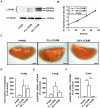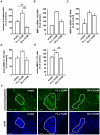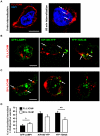Full-length L1CAM and not its Δ2Δ27 splice variant promotes metastasis through induction of gelatinase expression
- PMID: 21541352
- PMCID: PMC3081839
- DOI: 10.1371/journal.pone.0018989
Full-length L1CAM and not its Δ2Δ27 splice variant promotes metastasis through induction of gelatinase expression
Abstract
Tumour-specific splicing is known to contribute to cancer progression. In the case of the L1 cell adhesion molecule (L1CAM), which is expressed in many human tumours and often linked to bad prognosis, alternative splicing results in a full-length form (FL-L1CAM) and a splice variant lacking exons 2 and 27 (SV-L1CAM). It has not been elucidated so far whether SV-L1CAM, classically considered as tumour-associated, or whether FL-L1CAM is the metastasis-promoting isoform. Here, we show that both variants were expressed in human ovarian carcinoma and that exposure of tumour cells to pro-metastatic factors led to an exclusive increase of FL-L1CAM expression. Selective overexpression of one isoform in different tumour cells revealed that only FL-L1CAM promoted experimental lung and/or liver metastasis in mice. In addition, metastasis formation upon up-regulation of FL-L1CAM correlated with increased invasive potential and elevated Matrix metalloproteinase (MMP)-2 and -9 expression and activity in vitro as well as enhanced gelatinolytic activity in vivo. In conclusion, we identified FL-L1CAM as the metastasis-promoting isoform, thereby exemplifying that high expression of a so-called tumour-associated variant, here SV-L1CAM, is not per se equivalent to a decisive role of this isoform in tumour progression.
Conflict of interest statement
Figures






Similar articles
-
Role of L1 cell adhesion molecule (L1CAM) in the metastatic cascade: promotion of dissemination, colonization, and metastatic growth.Clin Exp Metastasis. 2014 Jan;31(1):87-100. doi: 10.1007/s10585-013-9613-6. Epub 2013 Sep 4. Clin Exp Metastasis. 2014. PMID: 24002299
-
Social defeat stress promotes tumor growth and angiogenesis by upregulating vascular endothelial growth factor/extracellular signal-regulated kinase/matrix metalloproteinase signaling in a mouse model of lung carcinoma.Mol Med Rep. 2015 Jul;12(1):1405-12. doi: 10.3892/mmr.2015.3559. Epub 2015 Mar 27. Mol Med Rep. 2015. PMID: 25824133
-
L1CAM-integrin interaction induces constitutive NF-kappaB activation in pancreatic adenocarcinoma cells by enhancing IL-1beta expression.Oncogene. 2010 Aug 26;29(34):4766-78. doi: 10.1038/onc.2010.230. Epub 2010 Jun 14. Oncogene. 2010. PMID: 20543863
-
L1 cell adhesion molecule (L1CAM) in invasive tumors.Cancer Lett. 2009 Sep 18;282(2):137-45. doi: 10.1016/j.canlet.2008.12.021. Epub 2009 Jan 13. Cancer Lett. 2009. PMID: 19144458 Review.
-
L1CAM in human cancer.Int J Cancer. 2016 Apr 1;138(7):1565-76. doi: 10.1002/ijc.29658. Epub 2015 Aug 25. Int J Cancer. 2016. PMID: 26111503 Review.
Cited by
-
Exploratory analysis of immunomodulatory factors identifies L1CAM as a prognostic marker in alveolar soft-part sarcoma.Ther Adv Med Oncol. 2024 Nov 4;16:17588359241293951. doi: 10.1177/17588359241293951. eCollection 2024. Ther Adv Med Oncol. 2024. PMID: 39502403 Free PMC article.
-
In silico analyses and global transcriptional profiling reveal novel putative targets for Pea3 transcription factor related to its function in neurons.PLoS One. 2017 Feb 3;12(2):e0170585. doi: 10.1371/journal.pone.0170585. eCollection 2017. PLoS One. 2017. PMID: 28158215 Free PMC article.
-
Molecular targets and pathways involved in liver metastasis of colorectal cancer.Clin Exp Metastasis. 2015 Aug;32(6):623-35. doi: 10.1007/s10585-015-9732-3. Epub 2015 Jun 24. Clin Exp Metastasis. 2015. PMID: 26104118 Review.
-
Oncogenic alternative splicing switches: role in cancer progression and prospects for therapy.Int J Cell Biol. 2013;2013:962038. doi: 10.1155/2013/962038. Epub 2013 Oct 27. Int J Cell Biol. 2013. PMID: 24285959 Free PMC article. Review.
-
L1 Cell Adhesion Molecule in Cancer, a Systematic Review on Domain-Specific Functions.Int J Mol Sci. 2019 Aug 26;20(17):4180. doi: 10.3390/ijms20174180. Int J Mol Sci. 2019. PMID: 31455004 Free PMC article.
References
-
- Moos M, Tacke R, Scherer H, Teplow D, Fruh K, et al. Neural adhesion molecule L1 as a member of the immunoglobulin superfamily with binding domains similar to fibronectin. Nature. 1988;334:701–703. - PubMed
-
- Reid RA, Hemperly JJ. Variants of human L1 cell adhesion molecule arise through alternate splicing of RNA. J Mol Neurosci. 1992;3:127–135. - PubMed
-
- Breitbart RE, Andreadis A, Nadal-Ginard B. Alternative splicing: a ubiquitous mechanism for the generation of multiple protein isoforms from single genes. Annu Rev Biochem. 1987;56:467–495. - PubMed
-
- Pajares MJ, Ezponda T, Catena R, Calvo A, Pio R, et al. Alternative splicing: an emerging topic in molecular and clinical oncology. Lancet Oncol. 2007;8:349–357. - PubMed
Publication types
MeSH terms
Substances
LinkOut - more resources
Full Text Sources
Molecular Biology Databases
Research Materials
Miscellaneous

